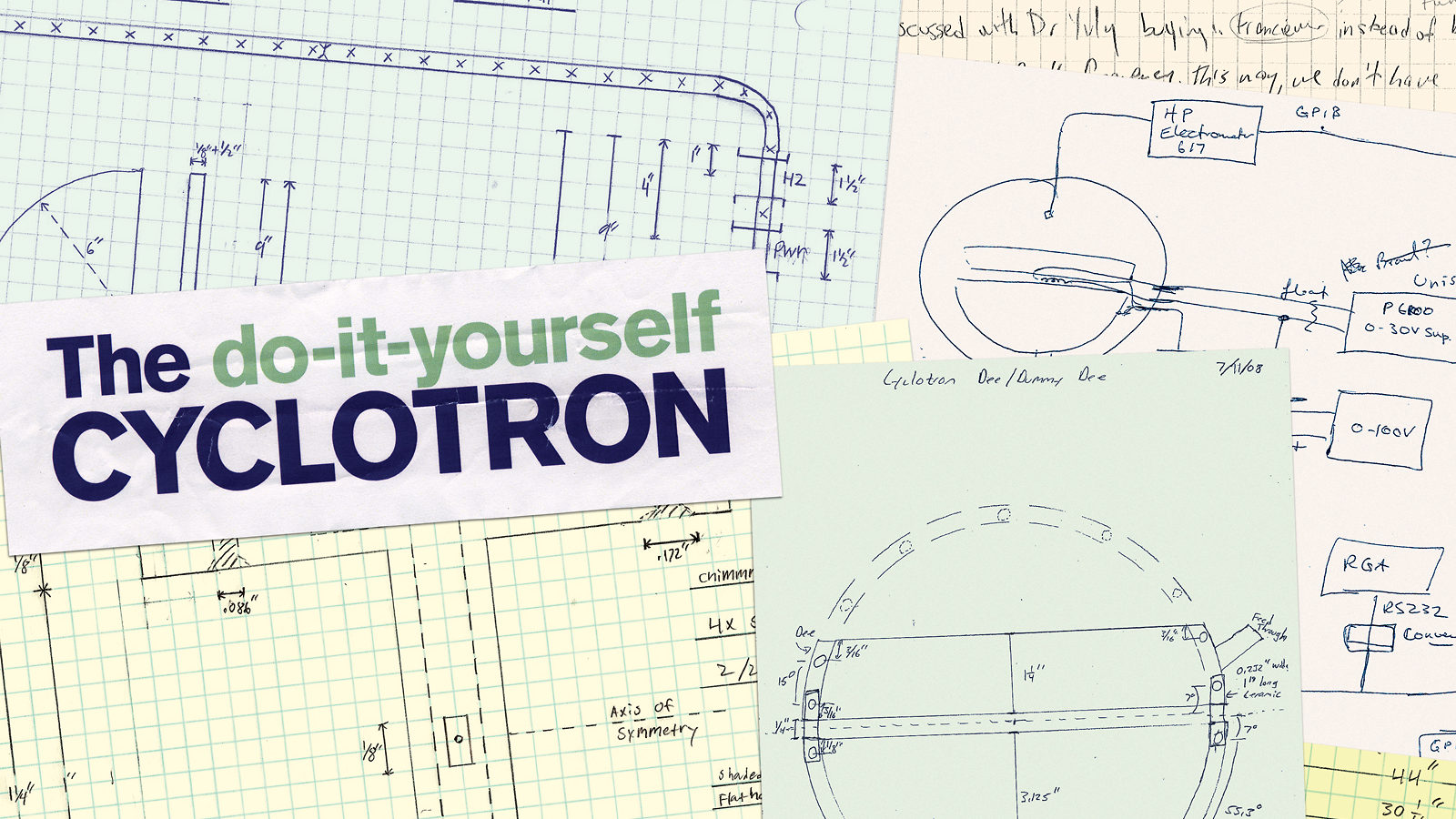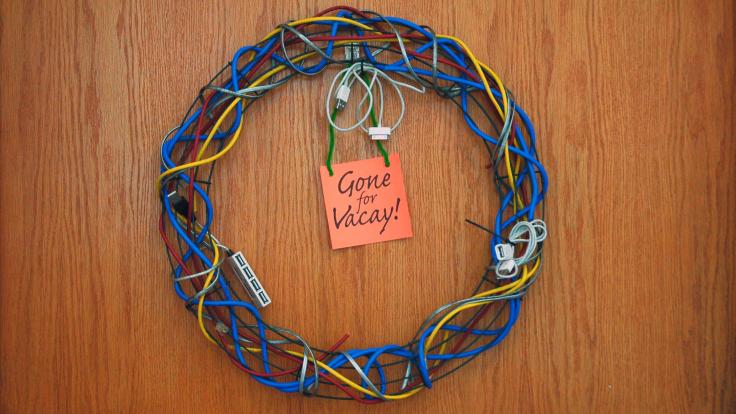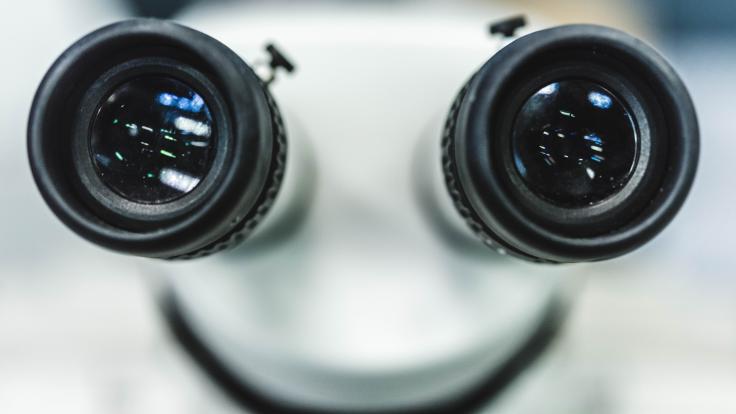If the only thing amateur car builders needed was a ride to work, they wouldn’t ever build cars. While it’s certainly nice to take the finished product around the block to show the neighbors, there’s something more than transportation motivating a hot-rod builder.
That’s the analogy Mark Yuly uses for a project he’s working on with his undergraduate physics students at Houghton College: building a particle accelerator.
Yuly belongs to a rare breed of people who have a deep fascination—you could even call it an obsession—with cyclotrons. For many of those obsessed, the only way to satiate their hunger for these machines is to build their own. There are no guidebooks or instruction manuals, and if you bought the raw materials off the shelf, it would cost around $125,000. On average, amateur cyclotrons take two to three years to build. And while it would drive some people crazy to build their own car and never drive it, in the 80-year history of amateur cyclotron building, only occasionally have the finished products been used for experiments or in education: Yuly says, “That’s not why we build them.”
“We” refers to amateur cyclotron builders. And last April, for the first time in history, they held a conference.
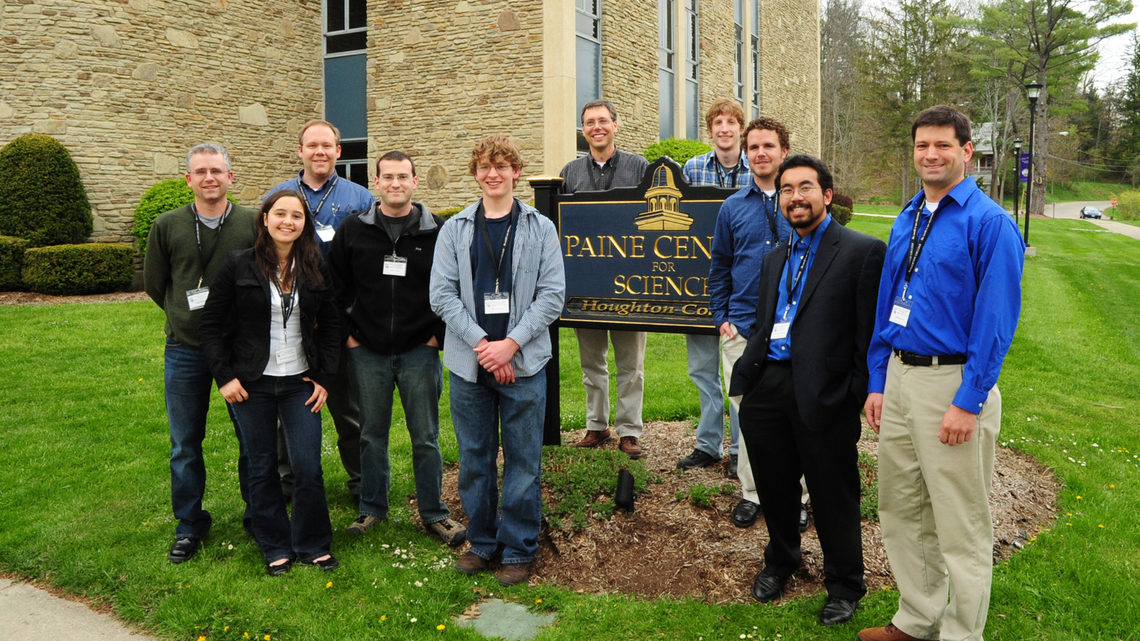
The cyclotroneers at the first amateur cyclotron conference at Houghton College in New York: Fred Niell, Heidi Baumgartner, Tim Koeth, Jeff Smith, Peter Heuer, Mark Yuly, Andrew Loucks, Tim Ponter, Raymond Jimenez, and James Krutzler.
First meetings
On a chilly but bright Saturday morning, Yuly awaits the arrival of his guests, his boyish smile stretched from ear to ear. He has specific questions for the visitors about some trouble he is having with his own cyclotron, but most of all, he says, “I’m just looking forward to the chance to meet all these people I’ve been corresponding with over the years.”
The Houghton College campus lies more than 300 miles from the closely packed chaos of New York City, and miles from major highways and chain stores. Draped in green farmland and forest, it rests languidly in the middle of nowhere.
Fifteen people from as far away as California, Illinois, and Washington, DC, trickle into the Houghton science building for the Small Cyclotron Conference. Of the four women in attendance, two have come to report on the meeting, while another joined her husband for the ride. The men are in mixed attire from jeans to suits, with a noticeable few who look younger than 30. Not everyone who ever built their own cyclotron is here—there are probably another 10 of them alive in the world—but it’s a strong sampling.
The strangers gather in the lobby of the science building, share a spread of coffee and pastries, shake hands, and exchange names. The natural awkwardness of a first meeting dampens the air, but a nervous excitement lifts it up. Most of the builders completed their monumental tasks in isolation. Their driving desire links them to each other, and to the long line of people who built cyclotrons before them.
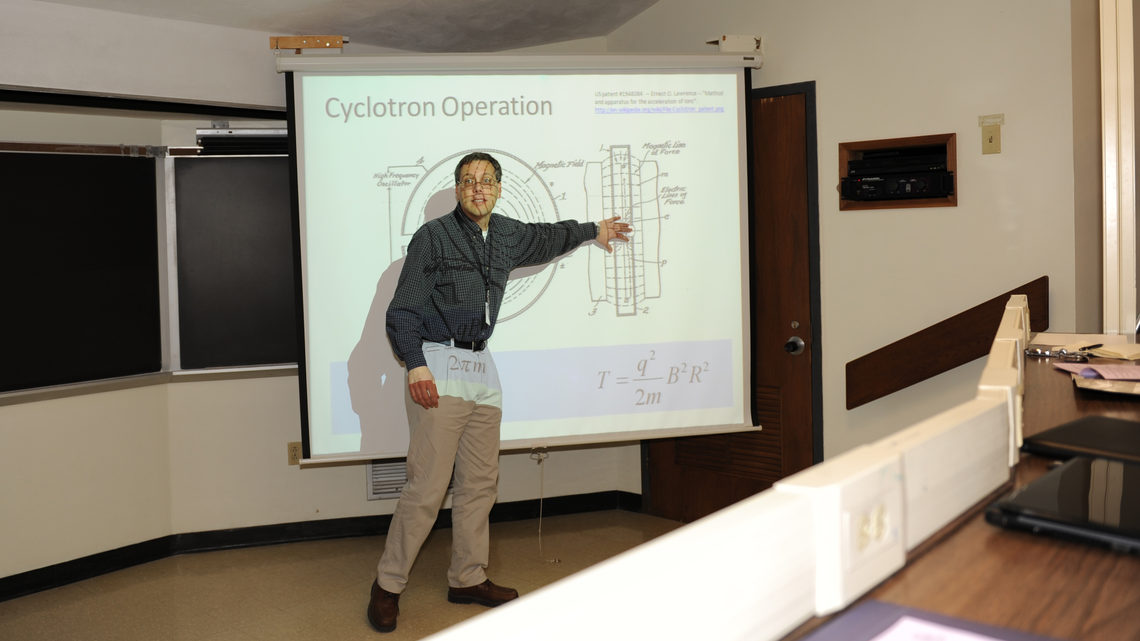
Conference host Mark Yuly delivers a presentation about the amateur cyclotron he built with his students at Houghton College. Yuly uses the cyclotron as a teaching tool and research project for his undergraduate students
Harder than it sounds
It’s actually rather easy to accelerate particles in your own home. When you turn on a fluorescent lamp, the eerie glow comes from electrons accelerating off the filament. With slightly more complex technology, it is also possible to accelerate an entire atom, albeit with some of its electrons stripped away; in this configuration it’s called an ion. Put that hardware inside a metal chamber, create a vacuum to get rid of all the other particles in the air, add a magnet to steer the ions in circles, and use radio waves to speed them up, and you’ve got yourself a cyclotron. Then make a particle detector of your choice—something to shoot the ions at—and you can put your ions to work.
Sound easy?
A commercially built cyclotron can cost anywhere from a few hundred thousand to a few hundred million dollars and take months to build. The core of the cyclotron is the chamber: two metal canisters shaped like the letter “D,” placed back to back to make a circle. Inside the chamber, the particles spiral around and around. Amateur cyclotron chambers are usually only a few inches to a foot across—small enough to hold in your hand. The very smallest, made by Fermilab employee Chris Olsen, is eight centimeters in diameter. The world’s largest cyclotron runs at TRIUMF, Canada’s national laboratory for particle and nuclear physics located at the University of British Columbia campus in Vancouver, and is 60 feet in diameter.
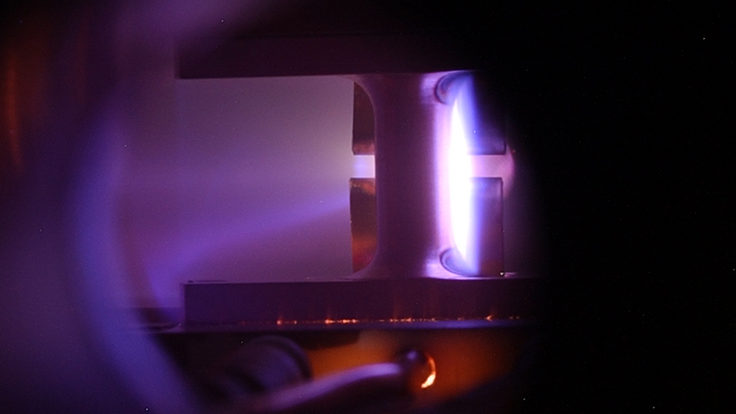
Ions in the Rutgers cyclotron spiral down during a test run.
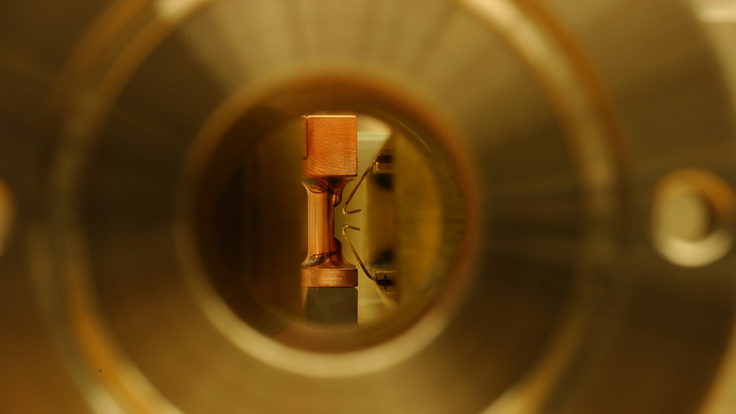
A view of the cyclotrons ion source through a vacuum-tight view port.
From the side of the metal chamber sprout various appendages, giving the impression of a bizarre, circular Swiss army knife. These include, but are not limited to, the filament, which generates the ions; the vacuum pump that removes all other particles from the chamber; a window looking into the chamber, where you can sometimes see a glow as the ions accelerate; and the detector.
The largest piece of a cyclotron is the magnet. Tim Koeth, the conference’s lead organizer, designed his cyclotron at Rutgers University while an undergraduate physics student. It has a metal chamber 13 inches in diameter; its magnet is three feet high, four feet wide, and weighs 4600 pounds. A commercially produced magnet of that size might cost more than $10,000, but Koeth and some student helpers had the good fortune to find the magnet, originally manufactured for another cyclotron, going unused at Argonne National Laboratory, which generously donated it to their cause. The ability to track down treasures like these is a necessary skill for amateur cyclotron builders.
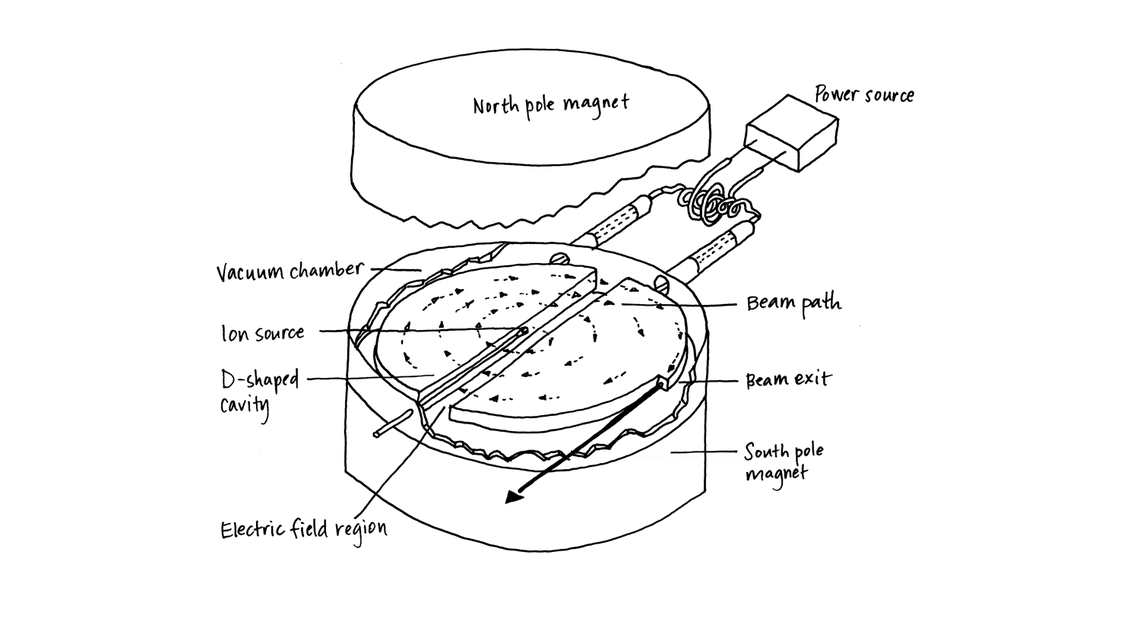
In a cyclotron, ions gain speed every time they cross the alternating electric field created by two D-shaped cavities. Magnets steer the accelerating ions along a spiral path until they exit the cyclotron.
Treasure hunting
Fred Niell built his cyclotron as a high-school student, and with it won the grand prize at the International Science and Engineering Fair: a trip to Sweden to see the Nobel Prize proceedings as a guest of the Swedish Academy of Sciences, where he met the Swedish royal family and danced with Princess Victoria. Now an electrical engineer with his own business, Niell remains up to speed on where to find the equipment to build a cyclotron. He’s the one who estimated the cost of all the parts and services needed to build a small cyclotron—not including the builder’s time—at about $125,000.
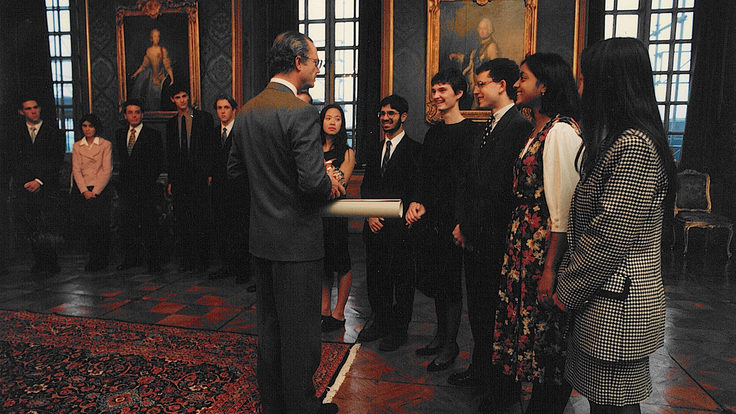
King Carl XVI Gustaf of Sweden addresses young scientists, including amateur cyclotron builder Fred Niell, who won a trip to the 1994 Nobel Prize ceremony for his amateur cyclotron.
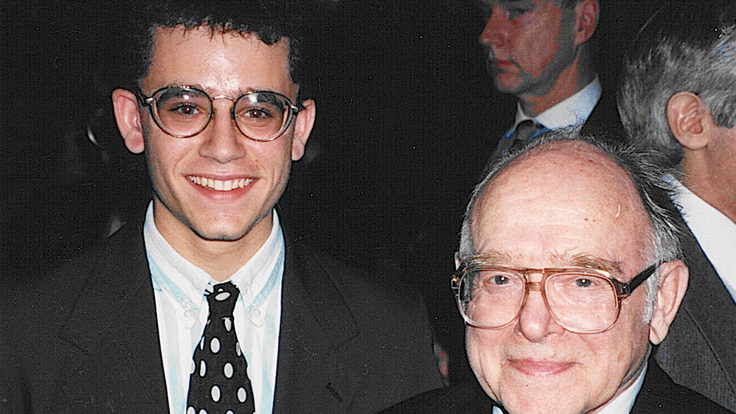
The young Niell with Clifford Shull, one of two Physics Nobel Prize recipients that year.
No one at the meeting, even those with sponsors, has anywhere near that much money.
But that’s only if you buy everything new. To get stuff cheap or even free, Niell says builders can hunt for materials on websites such as eBay and craigslist (an open classifieds page, more often dedicated to apartment rentals and old furniture), as well as on lesser-known gems, such as a site where the United States government liquidates materials formerly used by the armed forces.
Even more effective, he says, is knocking on doors, calling up shops, and discussing your project with people. The younger and more inexperienced builders have more luck with this, he says, because of the “cuteness factor.” Although the vast majority of people would never have the drive or desire to build their own cyclotron, in Niell’s experience most people jump at the chance to help out someone who does.
“I’ve definitely had old scientists or machine-shop guys sort of live vicariously through me,” he says.
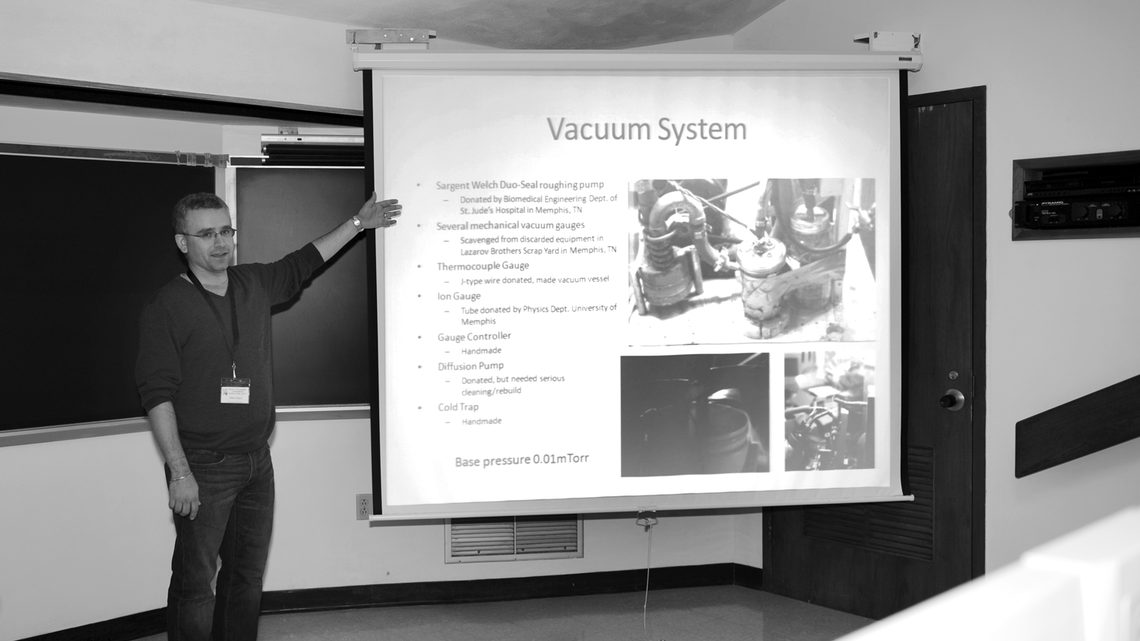
At the Amateur Cyclotron Conference, Niell discusses how to build a cyclotron on a budget.
Lots of eager helpers
Every one of the attendees can recount an instance when someone showed them an act of kindness, gave them something for free, or assisted them in some way.
Case in point: when symmetry ran a story online about the meeting’s two youngest attendees, 17-year-old Heidi Baumgartner and 18-year-old Peter Heuer, a man who worked for a company that makes vacuum pumps contacted them and sent them one free.
“It’s such an audacious project,” Heuer says. “And I guess people want to donate to things that are inspiring.”
Baumgartner and Heuer are building their cyclotron at the Thomas Jefferson National Accelerator Facility, where they have space and a small amount of funding but are left to their own devices to build the machine. The benefit of their location is the population of specialists in their immediate vicinity.
“We usually corner them at lunch and ask if we can talk to them for a few minutes,” Baumgartner says. “And then they end up talking to us for two hours.”
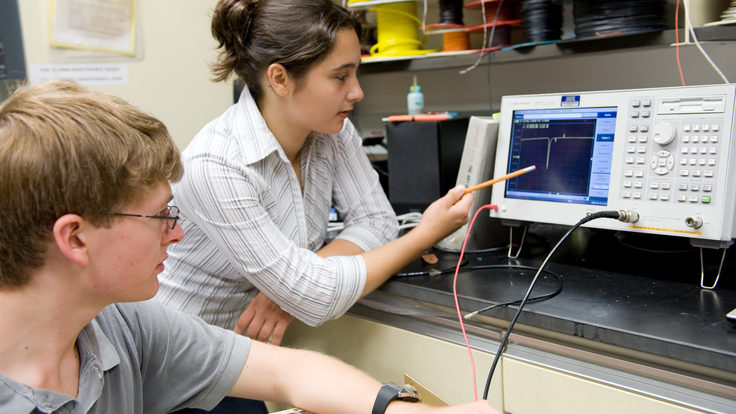
Peter Heuer and Heidi Baumgartner, aka The Cyclotron Kids, work on their cyclotron at Thomas Jefferson National Accelerator Facility.
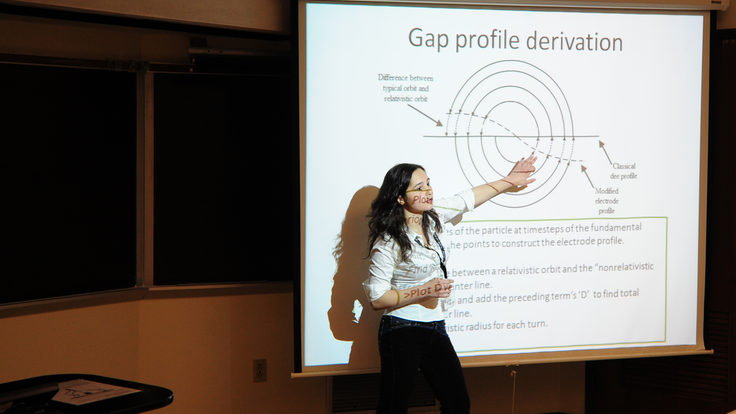
Baumgartner presents a new design for cyclotron “Ds” at the Amateur Cyclotron Conference.
Tools for science and medicine
When you accelerate particles and fire them at a target, the collision reveals properties of the target material much smaller than visual microscopes can see. For a long time cyclotrons were mostly used to study nuclear physics, which focuses on the structures and interactions of the nuclei of different types of atoms. Over the years, linear accelerators and synchrotrons have surpassed cyclotrons in terms of particle energies. Machines like the Large Hadron Collider produce energies much higher than cyclotrons can achieve and bring two particle beams into head-on collision; cyclotrons can only aim beams at fixed targets.
Nonetheless, for many modern applications cyclotrons offer particle beams of sufficient energy while using less space and electricity.
Today, cyclotrons are most widely used in medicine. Cyclotrons generate particles used in medical imaging techniques such as PET, or Positron Emission Tomography, that penetrate skin and muscle and create images of the inside of a patient. Cyclotrons can also produce radioisotopes—unstable nuclei that emit radiation when they decay to a stable form—used in medical imaging and cancer radiation treatment.
By the mid to late 1950s, laboratories and private companies had commercialized the production of cyclotrons. This eliminated the need for people who could build an entire cyclotron themselves, but it didn’t eliminate the desire.
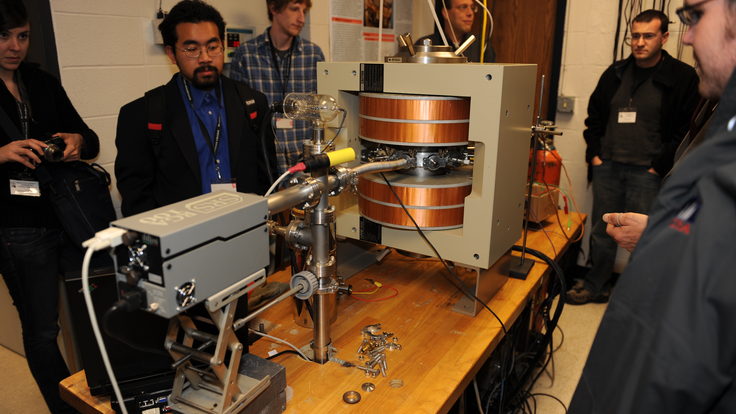
Conference-goers tour the Houghton College cyclotron.
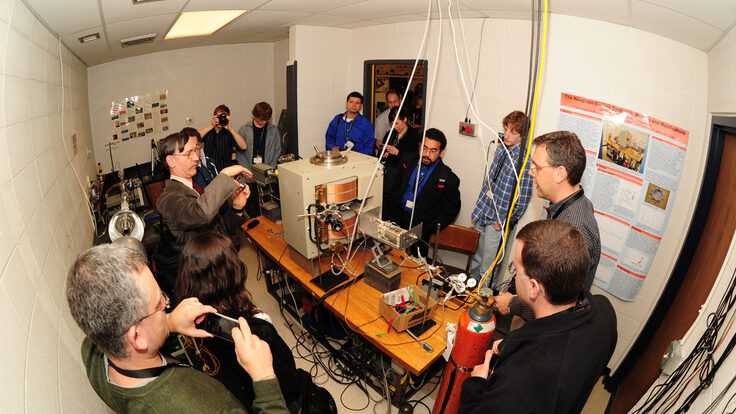
Conference-goers tour the Houghton College cyclotron.
Particles in the basement
In 1947, an article in Physics Today featured four teenagers at El Cerrito High School in California who, with the assistance of a teacher, built their own cyclotron. In 1951, three high school boys in Fort Wayne, Indiana, remodeled their high school basement to make room for their cyclotron laboratory. By the time the principal found out, they were already working on the accelerator. The group made another important stride when they decided to keep careful notes, a blueprint for amateur builders to come. Four amateur cyclotrons appeared in the 1950s, including one in Korea, and another in the 1960s. Then the scene went quiet until the 1990s, when five new amateur cyclotrons appeared, including those built by conference organizer Tim Koeth and attendees Jeff Smith and Fred Niell. The other attendees all began building their cyclotrons after 2000.
What strange bug has infected people, decade after decade, with the drive to embark on such a grueling journey?
“It really is a love of this machine,” says Jeff Smith, who built his cyclotron in college and now works as an accelerator scientist at SLAC National Accelerator Laboratory. “I think even people who work in the field [of accelerator science] are more interested in the experiment and don’t always have this kind of passion for the actual machine.”
Some amateur cyclotron builders did perform experiments with their completed projects. Yuly has some specific experiments he’d like to do with the Houghton cyclotron when he and his students get it running at a slightly higher energy. Baumgartner and Heuer have the ambitious goal of using theirs to create antimatter, and then hope to leave it at Jefferson Lab for other students to use.
But that’s rare; few amateur builders pursue research with their machines. Niell got his cyclotron working just before he graduated from high school, and left it there when he went to college. He found out later that it had had been dismantled for parts. Smith’s is still in the basement of Knox College. He says a student once tried to tinker with it, but didn’t follow through.
“I do feel an attachment to it,” Smith says. “I don’t want to hang it on the wall, but it would be nice to know that someone was getting some use out of it.”
A nifty learning tool
The cyclotrons at Rutgers and Houghton have now seen a few generations of students get involved in their construction and design. The impact that the experience has on them varies from minimal to life changing. Yuly says even if the students don’t wind up studying accelerator physics, the project is a rich learning tool for undergraduates.
“It involves electric and magnetic fields, nuclear physics, quantum mechanics, electronics, computer programming,” he explains. “In almost every course that an undergraduate physics major takes, there are some topics that are directly applied to building a cyclotron.”
Tim Ponter started working on the Rutgers cyclotron in the spring of 2009 as part of an undergraduate research class. He had no prior exposure to accelerator physics, but found that building a cyclotron incorporated a number of topics that already interested him. He continued work on the machine after finishing the course, and as a direct result of his work earned a summer internship with an accelerator group at the University of Maryland.
“It didn’t take long to become obsessed,” Ponter wrote in an email. “Where I would be without the cyclotron project I cannot even begin to imagine.”
In searching for common threads among cyclotron builders, it’s hard not to notice the frequent appearances of Fermi National Accelerator Laboratory. Two of the Fort Wayne high school students went on to work at Fermilab. Niell worked there for eight years. Fermilab employees Ron Walker and Chris Olsen each built cyclotrons while working there (Olsen actually built three). Olsen then assisted Smith, an undergraduate who had been introduced to cyclotrons at a Fermilab public lecture, in building his own machine. After Koeth built his cyclotron, he went on to do his PhD work at Fermilab. Even one of Fermilab’s key founders, Robert Wilson, worked in E.O. Lawrence’s Rad Lab in Berkeley in the 1930s and helped build a 37-inch cyclotron. Koeth says it is Fermilab’s you-can-do-it attitude that seems to attract the kinds of people who join the amateur cyclotron club.
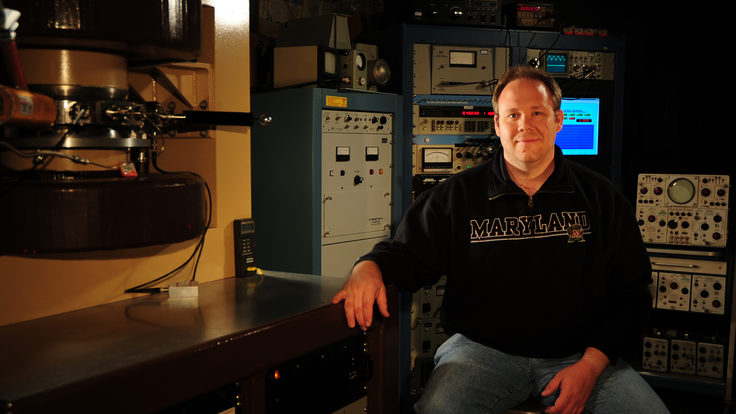
Building his own cyclotron at Rutgers, which he used as a teaching tool, prompted Tim Koeth to return to grad school in accelerator physics.
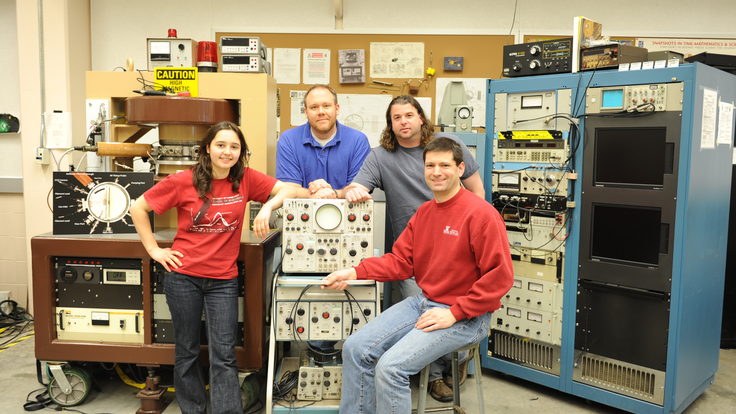
From left: Amateur cyclotron builders Heidi Baumgartner, Tim Koeth, Dan Hoffman, and James Krutzler.
A lifelong achievement
Koeth, who set up a website about the cyclotron he built at Rutgers, gets a handful of emails every year from people, mostly students, who say they want to build their own cyclotron. The students usually inform Koeth that they have one semester and a few hundred dollars. He says he tries not to discourage anyone, but the authors of those emails clearly lack perspective on how much time and money are required. The rare exception was the email he received from Baumgartner and Heuer, which Koeth says came off as more tenacious and definitely better researched than the others. Now the two have set up their own website, and receive the same kinds of emails.
Though few people might understand the obsession that brought these people together, their gifts aren’t lost on the rest of the world. The last common thread that the meeting attendees share is the way their cyclotrons have changed their lives. Whether getting them into school or a job, or simply reshaping the job they already had, building a cyclotron has a lot to do with where they are today.
“If you build one in high school, it will get you into college. If you build one in college it will get you into grad school, and so on,” Koeth says. “It’s a distinction that will never leave you.”



